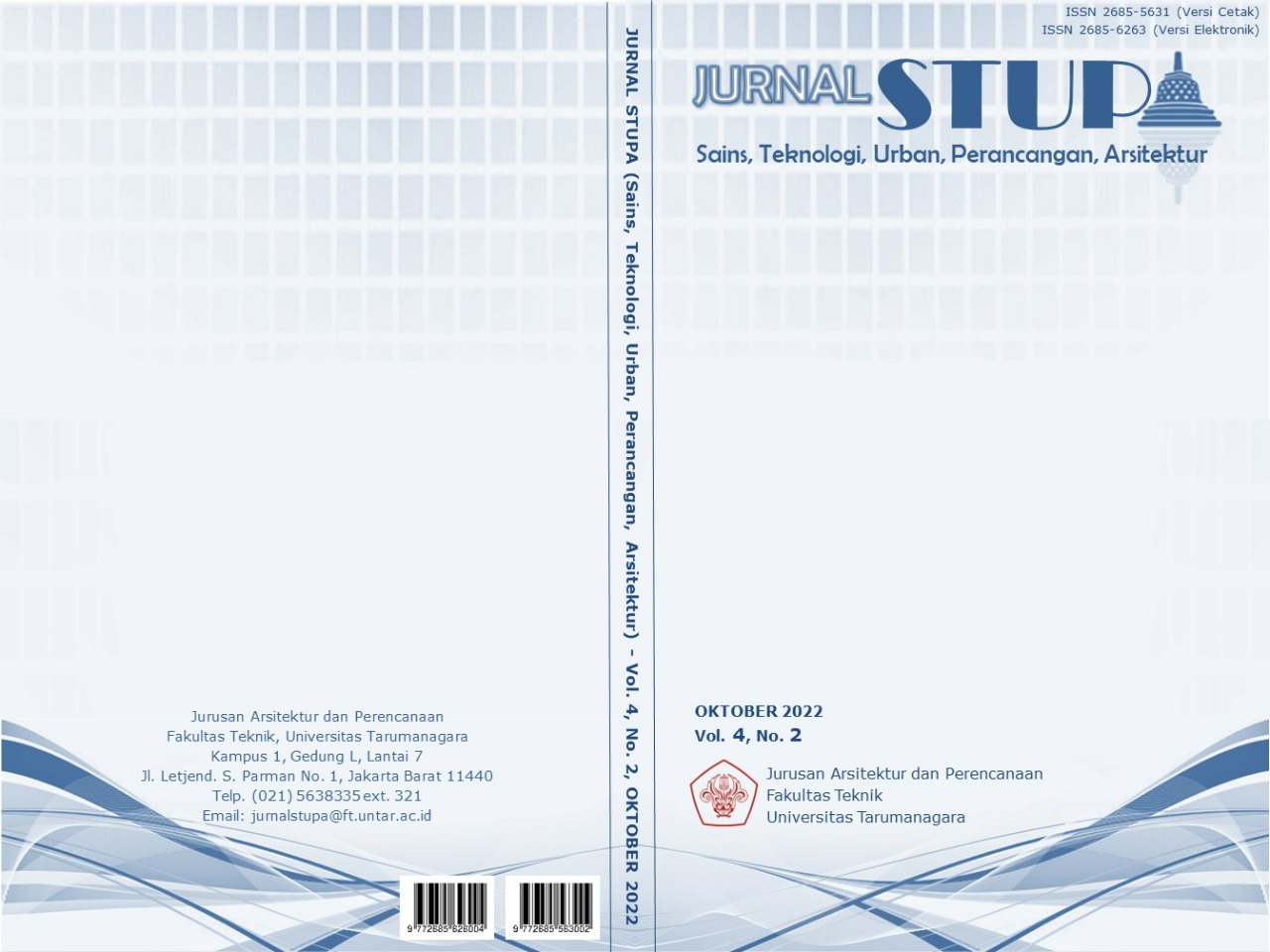PENDEKATAN TIPOLOGI PADA DESAIN RUANG SOSIAL MASYARAKAT TIONGHOA DALAM UPAYA MENGEMBALIKAN CITRA KAWASAN GLODOK
Main Article Content
Abstract
Social space is rooted to the identity of the community, which also becomes the image of a region. However, a shift in social structure in a region is inevitable due to demands of modern economy and urban development. When the identity-forming agent of this region shifts, the identity of the region will slowly fade and change. In this study, the author chose Glodok as the region that experienced a similar case. The strong social behavior, meaning, and identity of the Chinese community in Glodok resulted in a typology and character of social space that is unique compared to other regions. The recently-build-social spaces in Glodok only appear to reflect the regional image physically, but do not really reflect the spirit and values of the Chinese community in Glodok. This happens due to the large number of new entrants and rebranding efforts for the sake of modern market demand. Therefore, it is necessary to have an architectural strategy in the form of a socio-cultural space that can record the local soul of the Glodok area and instill it slowly in the long term as part of the lives of new residents in the future. To avoid a similar case in Glodok today, a typological approach is used to understand the reasons behind the program, form, and spatial arrangement of the socio-cultural space in Glodok. This typological approach must be able to rebuild the value and familiarity of Glodok as well as produce a new modification to meet the demands of the modern market. The basic typological approach used is by extracting the spatial patterns of Glodok and the daily life of the Glodok people, superimposing the spatial layers, and reinterpreting traditional Chinese architectural elements which are then transformed into a mass.
Keywords: Glodok; Identity; Image of Region; Social space; Typology
Abstrak
Ruang sosial dalam suatu kawasan mengakar pada identitas komunitasnya, yang menjadi citra dari kawasan tersebut. Namun, pergeseran struktur sosial dalam suatu kawasan tak terelakan karena tuntutan ekonomi modern dan perkembangan kota. Lantas, ketika agen pembentuk citra kawasan ini hilang, maka identitas dari kawasan pun turut memudar dan berubah jika berbicara dalam kurun waktu lama. Dalam penelitian ini, penulis memilih Glodok sebagai kawasan yang mengalami kasus serupa. Perilaku sosial, makna, dan identitas komunitas Tionghoa yang kuat di Glodok menghasilkan tipologi dan karakter ruang sosial yang berbeda dengan kawasan lain. Ruang-ruang sosial di Glodok yang baru hanya secara fisik luarnya seakan mencerminkan citra kawasan, tetapi tidak benar-benar mencerminkan jiwa dan nilai dari masyarakat Tionghoa di Glodok. Hal ini terjadi karena banyaknya pendatang baru dan upaya rebranding demi permintaan pasar modern. Oleh sebab itu, perlu adanya sebuah strategi arsitektur berupa ruang sosial budaya yang dapat merekam jiwa lokal kawasan Glodok dan menanamkannya secara perlahan dalam jangka panjang sebagai bagian dari kehidupan penghuni baru di masa mendatang. Untuk menghindari kasus serupa di Glodok sekarang, maka pendekatan tipologi digunakan untuk memahami alasan dibalik program, bentuk, dan tatanan spasial pada ruang sosial budaya di Glodok. Pendekatan tipologi ini harus dapat membangun kembali nilai dan familiaritas kawasan Glodok sekaligus menghasilkan sebuah modifikasi baru agar turut memenuhi permintaan pasar modern. Dasar pendekatan tipologi yang digunakan adalah mengekstraksi pola spasial Glodok serta keseharian masyarakat Glodok, meng-superimpose lapisan spasial tersebut, dan melakukan reinterpretasi terhadap elemen arsitektur tradisional Cina yang selanjutnya ditransformasi ke dalam gubahan.
Article Details

This work is licensed under a Creative Commons Attribution-NonCommercial-ShareAlike 4.0 International License.
This work is licensed under a Jurnal Sains, Teknologi, Urban, Perancangan, Arsitektur/ STUPA Creative Commons Attribution-NonCommercial-ShareAlike 4.0 International LicenseReferences
Ariani, D., 2006, Identifikasi Citra Kota Bandung Berdasarkan Persepsi Masyarakat, diunduh dari Prog. Studi PWK SAPPK-ITB. http://pwk.lib.itb.ac.id/index.php/bibliografi/detail/12420
Im, J., & Han, J. (2015). Typological Design Strategy of FOA′s Architecture. Journal of Asian Architecture and Building Engineering, 14(2), 443-449. .3130/jaabe.14.443
Khademi-Vidra, A. (2014). Identity Spaces. Social Analysis, 4, 109-120.
Masolo, D. A. (2002, 2). Community, identity, and the cultural space. Rue Descartes, 36, 19-51. Retrieved from https://www.cairn.info/revue-rue-descartes-2002-2-page-19.htm
Miao, P. (1990, Februari). Essence of Tradition-The 13 Characteristics of Chinese Traditional Architecture (English Translation). Journal of Building and Planning National Taiwan University, 5(1), 57-72. 10.13140/RG.2.2.31933.10727
Pandelaki, E. E., & et al. (2017). Typology of social space in Kauman Kampong Semarang. IOP Conf. Series: Earth Environ. Sci., 012011. 10.1088/1755-1315/99/1/012011
Rabbani, A. (2020, May 31). Definisi Ruang Sosial. Sosial79. Retrieved July 13, 2022, from https://www.sosial79.com/2020/05/definisi-ruang-sosial.html
Siagian, M. (2018). The social space in the making of identity (case: Pekan Labuhan, Medan, Indonesia). 8 IOP Conf. Ser.: Earth Environ. Sci. https://iopscience.iop.org/article/10.1088/1755-1315/126/1/012211/pdf
Sorokin, P. (1992). Chelovek. Tsivilizatsiya. Obshchestvo. (Manusia. Peradaban. Masyarakat.). M.: Politizdat, 542.
University of Washington, College of the Environment. (2018, August 16). Place Attachment & Meaning. Green Cities: Good Health. Retrieved July 01, 2022, from https://depts.washington.edu/hhwb/Thm_Place.html



